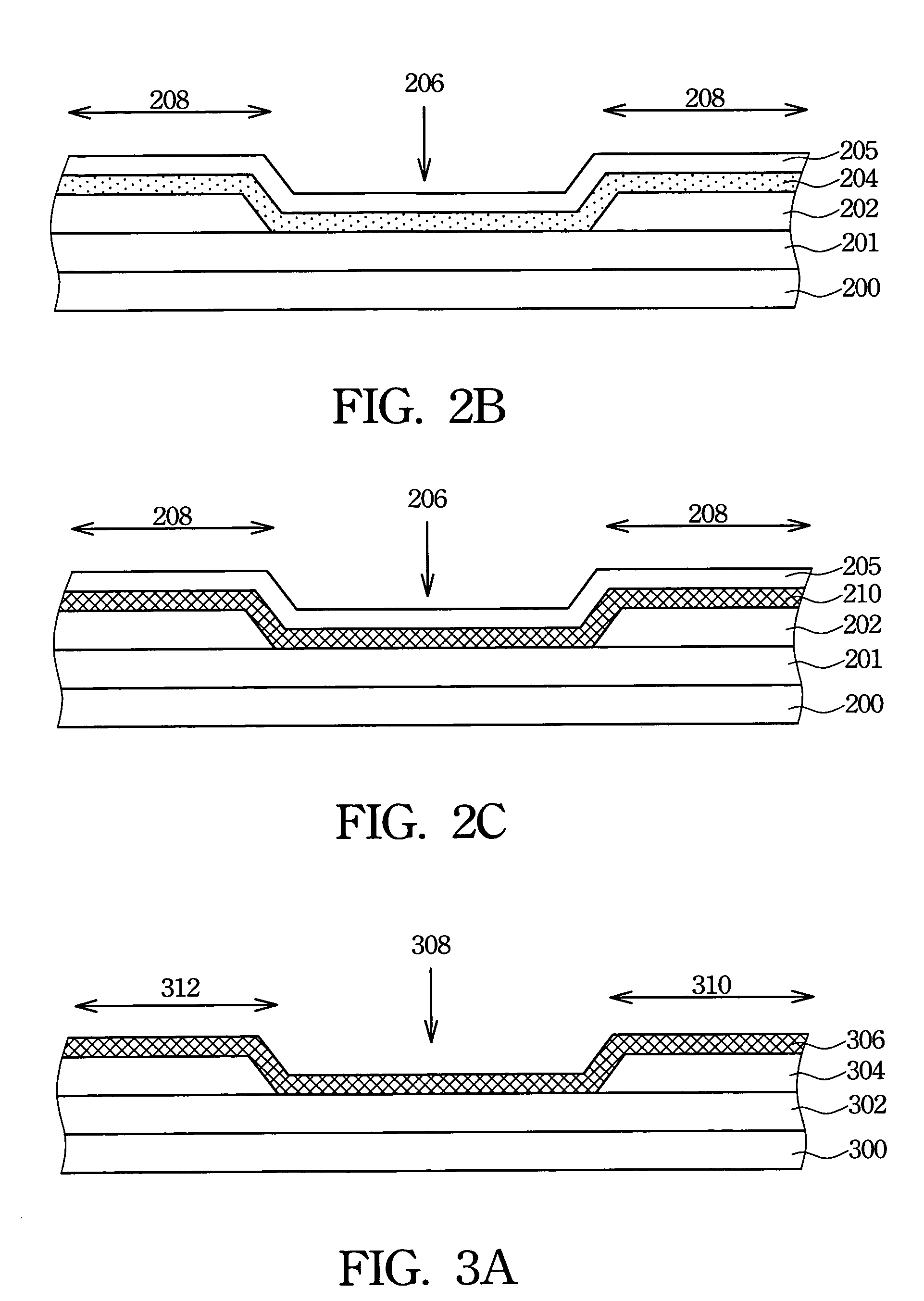Method of controlling polysilicon crystallization
a technology of polysilicon and crystallization, which is applied in the direction of crystal growth process, nuclear engineering, transportation and packaging, etc., can solve the problems of poor performance of polysilicon, worse than that of single crystalline silicon, and is not applicable to flat panel display fabrication. , to achieve the effect of improving the crystallization time, and improving the crystallization ra
- Summary
- Abstract
- Description
- Claims
- Application Information
AI Technical Summary
Benefits of technology
Problems solved by technology
Method used
Image
Examples
embodiment 1
[0022]The present invention discloses a method of controlling polysilicon crystallization. Referring to FIG. 1A, a heat sink layer 102 with a high heat conductive coefficient is first formed on a substrate 100 by, for example, plasma enhanced chemical vapor phase deposition (PECVD). The substrate 100 may be a glass substrate for display fabrication, and the heat sink layer 102 is a high heat conductivity material such as silicon nitride (SiNx) with heat conductive coefficient of 16-33 W / m2k. The preferable thickness of the heat sink layer 102 is about 100 nm.
[0023]Then, the heat sink layer 102 is patterned by, for example, photolithography and etching to form an opening 106. The foregoing etching may be plasma dry etching performed by providing gases with carbon ionic molecules such as, for example, carbon tetrafluoride (CF4). Next, an amorphous silicon layer 104 is formed on the heat sink layer 102 and in the opening 106 by, for example, PECVD or physical vapor deposition (PVD), an...
embodiment 2
[0026]The present invention discloses another method of controlling polysilicon crystallization. In addition to a material having high heat transfer property being used a heat sink layer, a heating layer having a heating function and a heat resist layer that retains warmth are also added to form another films structure for controlling polysilicon crystallization.
[0027]Referring to FIG. 2A, a heat resist layer 201 with a low heat conductive coefficient is first formed on a substrate 200 by, for example, PECVD, PVD, spin coating or solution-gelation (Sol-Gel). The substrate 200 may be a glass substrate, and the heat resist layer 201 is a poor heat conductor such as silicon oxide (SiOx) with heat conductive coefficient of 1.4 W / m2k. The heat conductivity of the heat resist layer is less than that of the substrate. Then, a heat sink layer 202 with a high heat conductive coefficient is formed on the heat resist layer 201 by, for example, PECVD. The heat sink layer 202 is a good heat cond...
embodiment 3
[0034]With the embodiments of the present invention employed, thin film materials chosen and structures designed, superior lateral growth polysilicon is obtained merely by excimer laser annealing; in addition to grain size, crystal location, grain order and uniformity of grain size are controlled well. Thus, the present invention can be further employed in thin film transistors fabrication to obtain devices with higher carrier mobility.
[0035]FIG. 3A illustrates a cross-sectional view of forming a channel region in a thin film transistor in accordance with a preferred embodiment of the present invention. When forming a thin film transistor structure of the present invention, a buffer layer 302 is first formed on a substrate 300 by, for example, PECVD. The substrate 300 may be a glass substrate, and materials of the buffer layer 302 may be SiOx. Then, a method of controlling polysilicon crystallization, for example, the first preferred embodiment of the present invention is used.
[0036...
PUM
| Property | Measurement | Unit |
|---|---|---|
| grain size | aaaaa | aaaaa |
| grain size | aaaaa | aaaaa |
| thickness | aaaaa | aaaaa |
Abstract
Description
Claims
Application Information
 Login to View More
Login to View More - R&D
- Intellectual Property
- Life Sciences
- Materials
- Tech Scout
- Unparalleled Data Quality
- Higher Quality Content
- 60% Fewer Hallucinations
Browse by: Latest US Patents, China's latest patents, Technical Efficacy Thesaurus, Application Domain, Technology Topic, Popular Technical Reports.
© 2025 PatSnap. All rights reserved.Legal|Privacy policy|Modern Slavery Act Transparency Statement|Sitemap|About US| Contact US: help@patsnap.com



